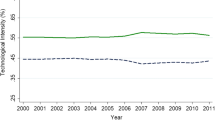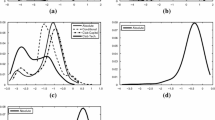Abstract
This paper examines the evolution of the patterns of specialisation of 11 Euro area countries in the period 1990–2008, by analysing their comparative and technological advantages. We estimate conditional densities and Markov transition probabilities to examine both the external shape of the distribution of technological and comparative advantages and the intra-distribution dynamics. Our results point out that there is, on average, high persistence of the industrial specialisation patterns of the 11 Euro area countries under scrutiny, confirming a lock-in effect, especially in the case of Italy. Our results for technological specialisation reveal high mobility of technological advantages over the same period, especially for Spain.
Similar content being viewed by others
Notes
Austria, the Belgium-Luxembourg Economic Union (BLEU), Finland, France, Germany, Greece, Ireland, Italy, Netherlands, Portugal and Spain.
In order to reduce the impact of outliers and the impact of wide variation in exchange rate or prices, we exclude the ’Crude oil and natural’ and ’Ores of uranium and thorium’ sectors.
For Greece and Portugal, we can only estimate three-by-three matrices for the STCA index due to their patent applications being concentrated in the first tertile.
See Appendix.
References
Alessandrini M, Fattouh B, Scaramozzino P (2007) The changing pattern of foreign trade specialisation in Indian manufacturing. Oxf Rev Econ Policy 23(2):270–291
Alessandrini M, Batuo ME (2010) The trade specialisation of SANE: Evidence from manufacturing industries. Eur J Comp Econ 7(1):145–178
Alvarez F, Lucas RE (2007) General equilibrium analysis of the Eaton? Kortum model of international trade. J Monet Econ 54(6):1726–1768
Amador J, Cabral S, Maria JR (2010) What can we learn from the distribution of trade patterns? Evidence for Portugal, Spain, Greece and Ireland. Port Econ J 9(2):77–95
Amemiya T (1984) Tobit models: a survey. J Econom 24(1–2):3–61
Amendola G, Guerriri P, Padoan PC (1992) International patterns of technological accumulation. J Int Comp Econ 1:173–197
Arthur WB (1989) Competing technologies, increasing returns and lock-in by historical events. Econ J 99(394):116–131
Arthur WB (1994) Increasing returns and path dependence in the economy. University of Michigan Press, Ann Arbor
Balassa B (1965) Trade liberalization and revealed comparative advantage. Manchester School Econ Soc Stud 33(2):99–123
Brasili A, Epifani P, Helg R (2000) On the dynamics of trade patterns. De Economist 148(2):233–257
Bulli S (2001) Distribution dynamics and cross-country convergence: a new approach. Scott J Polit Econ 48(2): 226–243
Cadot O, Carrére C, Strass-Kahn V (2011) Export diversification: What’s behind the hump? Rev Econ Stat 93(2):590–605
Cantwell J (1989) Technological innovation and multinational corporations. Blackwell Publisher, Oxford
Chiappini R (2011a) Dynamique des spécialisations et performances commerciales des Pays d’Europe Centrale et Orientale. Revue d’Etudes Comparatives Est-Ouest 42(2):165–193
Chiappini R (2011b) Comment mesurer la compétitivité structurelle des pays dans les équations d’exportation? L’Actualité économique 87(1):31–57
Dalum B, Laursen K, Villumsen G (1998) Structural change in OECD export specialisation patterns: de-specialisation and stickiness. Int Rev Appl Econ 12(3):423–443
David PA (1986) Understanding the economics of QWERTY: the necessity of history. In: Parker WN (ed) Economic history and the modern economist. Oxford, Blackwell
De Benedictis L, Tamberi M (2004) Overall specialisation empirics: techniques and applications. Open Econ Rev 15(4):323–346
Deardorff AV (1974) Factor proportions and comparative advantage in the long run: comments. J Polit Econ 82(4):829–833
Dornbusch R, Fischer S, Samuelson P (1977) Comparative advantage, trade and payments in a Ricardian model with a continuum of goods. Am Econ Rev 67(1):823–839
Dosi G (1988) Sources, procedures and microeconomic effects of innovation. J Econ Lit 26(3):1120–1171
Eaton J, Kortum S (2002) Technology, geography and trade. Econometrica 70(5):1741–1779
Ethier WJ (1979) Internationally decreasing costs and world trade. J Int Econ 9(1):1–24
Ethier WJ (1982) National and international returns to scale in the modern theory of international trade. Am Econ Rev 72(3):389–405
Findlay R (1970) Factor proportions and comparative advantage in the long run. J Polit Econ 78(1):27–34
Fujita M, Krugman P, Venables A (2001) The spatial economy: cities, regions and international trade. MIT Press, Cambridge
Hidalgo CA, Klinger B, Barabási A-L, Hausman R (2007) The product space conditions the development of nations. Sci 317(5837):482–487
Grossman GM, Helpman E (1990) Comparative advantage and long-run growth. Am Econ Rev 80(4):796–815
Grossman GM, Helpman E (1991) Innovation and growth in the global economy. MIT Press, Cambridge
Hall P, Racine JS, Li Q (2004) Cross-validation and the estimation of conditional probability densities. J Am Stat Assoc 99(468):1015–1026
Hausman R, Hwang J, Rodrik D (2007) What you exports matters. J Econ Growth 12(1):1–25
Hayfield T, Racine JS (2008) Nonparametric econometrics: the np package. J Stat Soft 27(5):1–32
Helpman E (1981) International trade in the presence of product differentiation, economies of scale and imperfect competition: a Chamberlain-Heckscher-Ohlin approach. J Int Econ 11(3):305–340
Helpman E, Krugman P (1985) Market structure and foreign trade: Increasing returns imperfect competition and the international economy. MIT Press, Cambridge
Hyndman RJ, Bashtannyk DM, Grunwald GK (1996) Estimating and visualizing conditional densities. J Comput Graph Stat 5(4):315–336
Hyndman RJ, Einbeck J (2009) The hdrce package (highest density regions and conditional density estimation). R package version 2.09
Krugman P (1987) The narrow moving band, the Dutch disease and the competitive consequences of Mrs Thatcher: notes on trade in the presence of scale economies. J Dev Econ 27(1-2):41–55
Krugman P (1991) Geography and trade. MIT Press, Cambridge
Lall S (2000) The technological structure and performance of developing country manufactured exports, 1985-98. Oxf Dev Stud 28(3):337–369
Lallement R, Mouhoud EM, Paillard S (2002) Polarisation et internationalisation des activités d’innovation: incidences sur la spécialisation technologique des nations. Région et Développement 16:17–54
Lucas R (1988) On the mechanics of economic development. J Monet Econ 22(1):3–22
Mancusi ML (2001) Technological specialisation in industrial countries. Rev World Econ (Weltwirschaftliches Archiv) 137(4):593–621
Mancusi ML (2012) National externalities and path-dependence in technological change: an empirical test. Econ 79(314):329–349
Markusen JR, Melvin JR (1981) Trade, factor prices, and the gains from trade with increasing returns to scale. Can J Econ 14(3):450–469
Narula R, Wakelin K (1998) Technological competitiveness, trade and foreign direct investment. Struct Change Econ Dyn 9(3):373–387
Patel P, Pavitt K (1991) Large firms in the production of the world’s technology: an important case of non-globalisation. J Int Bus Stud 22(1):1–21
Pavitt K (1989) International patterns of technological accumulation. In: Hood N, Vahlne J-E (eds) Strategies in global competition. Croom Helm Publisher, London, pp 126–151
Proudman J, Redding S (2000) Evolving patterns of international trade. Rev Int Econ 8(3):373–396
Quah DT (1993) Empirical cross-section dynamics in economic growth. Eur Econ Rev 37(2–3):426–434
Quah DT (1996) Empirics for economic growth and convergence. Eur Econ Rev 40(6):1353–1375
Quah DT (1997) Empirics for economic growth and distribution: stratification, polarization and convergence clubs. J Econ Growth 2(1):27–59
Redding S (2002) Specialisation dynamics. J Int Econ 58(2):299–334
Ricardo D (1817) On the principles of political economy and taxation, 3rd edn. (1821). John Murray, London
Schott P (2003) One size fits all? Heckscher-Ohlin specialization in global production. Am Econ Rev 93(3):686–708
Schott P (2004) Across product versus within-product specialization in international trade. Q J Econ 199(2):647–678
Shorrocks A (1978) The measurement of mobility. Econometrica 46(5):1013–1024
Soete LLG (1981) A general test of the technological gap trade theory. Weltwirtschaftliches Archiv 117(4):638–666
Uchida Y, Cook P (2005) The transformation of competitive advantage in East Asia: an analysis of technological and trade specialisation. World Dev 33(5):701–728
Wong K-Y (1995) International trade in goods and factor mobility. MIT Press, Cambridge
Xiang C (2007) Diversification cones, trade costs and factor market linkages. J Int Econ 71(2):448–466
Young A (1991) Learning-by-doing and dynamic effects of international trade. Q J Econ 106(2):396–406
Zaghini A (2005) Evolution of trade patterns in the new EU member States. Econ Trans 13(4):629–658
Acknowledgments
I am deeply indebted to one anonymous referee for valuable and helpful comments and suggestions. The usual disclaimers apply.
Author information
Authors and Affiliations
Corresponding author
Rights and permissions
About this article
Cite this article
Chiappini, R. Persistence vs. mobility in industrial and technological specialisations: evidence from 11 Euro area countries. J Evol Econ 24, 159–187 (2014). https://doi.org/10.1007/s00191-013-0331-7
Published:
Issue Date:
DOI: https://doi.org/10.1007/s00191-013-0331-7
Keywords
- Specialisation dynamics
- Revealed comparative advantage
- Technological comparative advantage
- Transition probability
- Conditional density
- Intra-distribution dynamics












